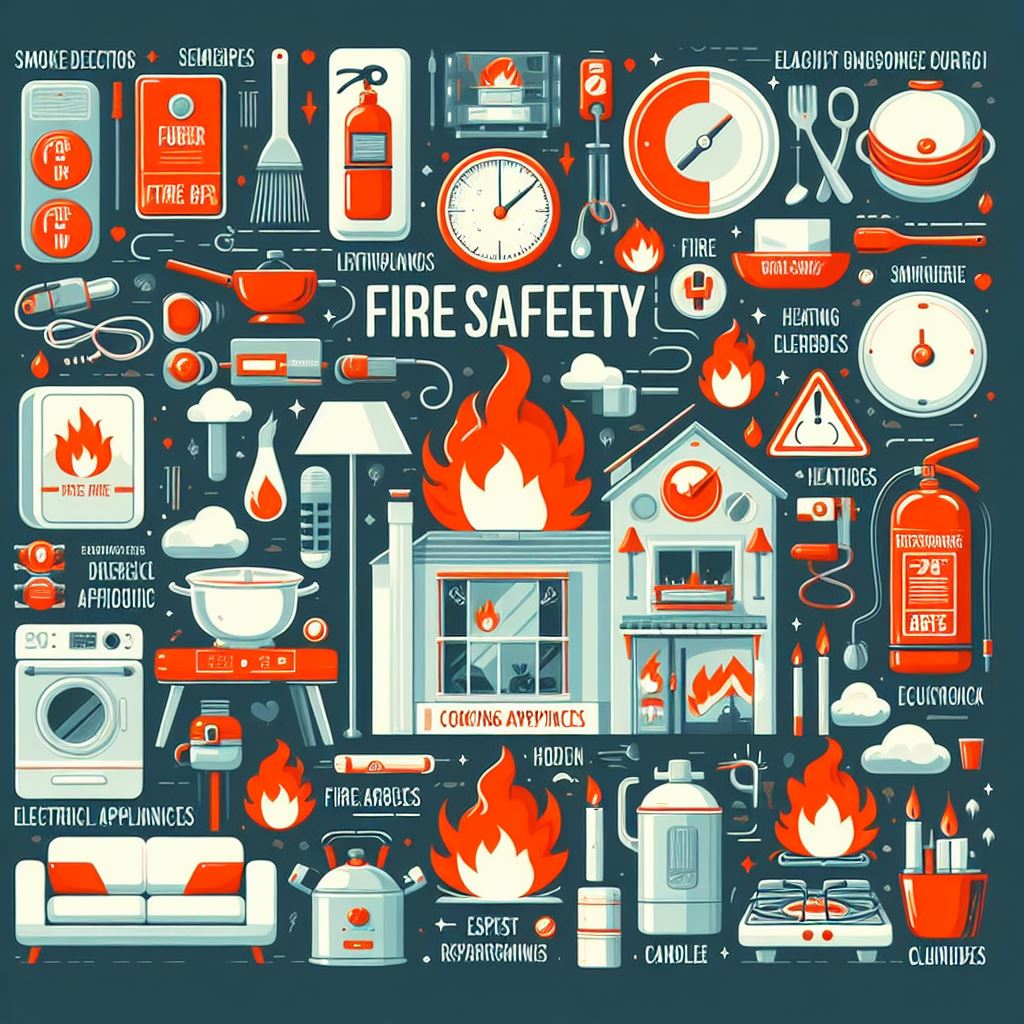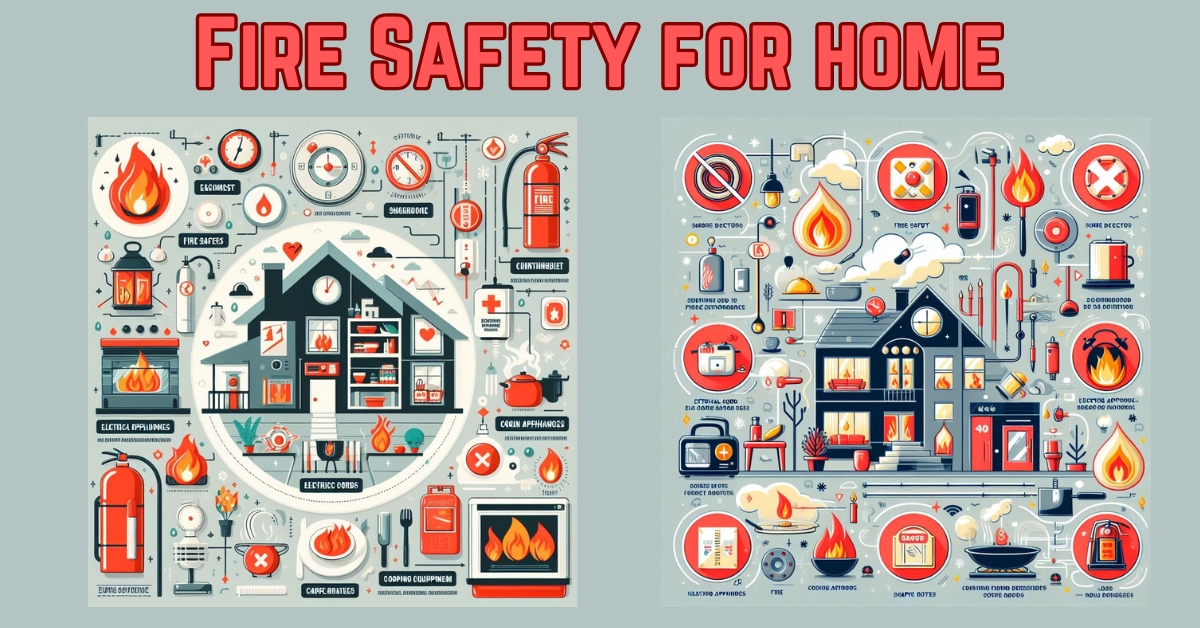Acknowledging the Risk and Seasonal Trends in Home Fires
Intriguingly, the sanctity of our homes is occasionally threatened by the unfortunate prospect of a house fire. Shockingly, statistics reveal that over 27% of reported fires take place within the confines of our homes, underscoring the need for heightened awareness and preventive measures.
As we delve into the fall and winter seasons, the risk intensifies, with December and January emerging as critical months. During this period, a surge in the use of candles, fireplaces, and space heaters becomes commonplace, inadvertently elevating the likelihood of fire incidents.
This article aims to shed light on the heightened vulnerability during these months, urging readers to adopt a proactive approach to safeguarding their homes against potential fire hazards. Understanding the seasonal dynamics and implementing preventive strategies can play a pivotal role in minimizing the risks and ensuring a safer living environment for all.
Importance of Fire Safety In Home
Understanding the importance of specific actions during a house fire is paramount, with staying low proving to be a crucial survival tactic. When a fire erupts, smoke tends to rise, carrying toxic gases and heat.
By staying close to the ground, individuals can minimize their exposure to these life-threatening elements, significantly reducing the risk of smoke and heat inhalation. Remaining upright during a fire can be perilous, as toxic smoke rises and could impair one’s ability to breathe.
In contrast, adopting recommended actions such as stop, drop, and roll can be instrumental in enhancing survival rates. This technique is particularly effective when a person’s clothing catches fire. By stopping immediately, dropping to the ground, and rolling to smother the flames, individuals can swiftly extinguish the fire and prevent further injuries.
The significance of these actions cannot be overstated, as they empower individuals with practical strategies to navigate through the chaos of a house fire, ultimately increasing their chances of survival and minimizing potential injuries. In essence, awareness and implementation of these life-saving techniques can make a profound difference in the face of a difficult situation.
Common Fire Hazards in the Home
Electrical Fires:
Electrical fires pose a significant threat in homes, often resulting from issues like short circuits and loose connections. To mitigate these risks, professional annual inspections by certified electricians are paramount. Regular maintenance can identify potential problems and prevent them from escalating into hazardous situations. Overburdening electrical systems, a common mistake in many households should be avoided. Ensuring that outlets are not overloaded with multiple appliances and devices helps maintain the integrity of the electrical infrastructure, reducing the likelihood of short circuits and sparks that could lead to a fire.
Cooking Fires:
Cooking fires are a prevalent cause of residential fires, often stemming from negligence or oversight in the kitchen. Staying in the kitchen while cooking is a fundamental safety guideline. Wearing appropriate clothing, such as tight-fitting sleeves, and avoiding loose accessories minimizes the risk of garments catching fire accidentally. Additionally, having a fire extinguisher readily available in the kitchen is crucial for immediate response in case of a small flare-up. Knowing how to use the extinguisher effectively is equally important, as prompt action can prevent a minor incident from escalating into a major fire.
Flammable Materials and Liquids:
Common household items like cleaning solvents, paints, and even everyday items like paper towels can become potential fire hazards if not handled and stored properly. Understanding the potential dangers of these flammable materials is essential. Store such items away from heat sources and in well-ventilated areas to mitigate the risk of accidental ignition. Clear labeling and awareness of the flammability of household products contribute significantly to a safer environment. Proper storage procedures, including keeping these materials away from open flames and ensuring tightly sealed containers, go a long way in reducing the likelihood of fires and associated injuries.
Space Heaters and Portable Heaters:
While space heaters and portable heaters offer warmth during colder months, their misuse can lead to fires. Safety precautions include maintaining a safe distance from flammable objects, such as curtains and furniture. Only using approved devices with built-in safety features adds an extra layer of protection.
Regularly inspecting heaters for any signs of damage and ensuring they meet safety standards is crucial. Educating household members on responsible usage and emphasizing the need to turn off heaters when not in use contributes significantly to minimizing fire risks associated with these devices.
Extension Cords:
Extension cords are ubiquitous in households, facilitating the use of electronic devices and appliances. However, improper use can pose significant fire hazards. Understanding the different types of extension cords and their applications is crucial. Indoor and outdoor use requires specific cord types, and exceeding amperage and voltage limits can lead to overheating and, eventually, fires. Regularly inspecting cords for damage, fraying, or exposed wires is essential for safety. Educating family members on these considerations and promoting responsible usage can prevent accidents and mitigate the risk of electrical fires stemming from extension cord misuse.
awareness and proactive measures are pivotal in preventing common fire hazards in homes. Implementing these safety guidelines can create a secure living environment, significantly reducing the likelihood of residential fires and the associated risks to life and property. Regular inspections, responsible usage, and a commitment to fire safety are essential components of fostering a secure home.
Prevention Strategies for Home Fire Safety

Safeguarding homes from potential fires requires proactive measures. Explore essential strategies, from the crucial role of alarms for the hearing and visually impaired to avoiding combustible materials and maintaining safe distances from heat sources. Implementing these practical steps ensures a secure living environment, minimizing the risk of devastating house fires.
Smoke Alarms and Carbon Monoxide Alarms:
Installing reliable smoke alarms and carbon monoxide detectors is a cornerstone of home fire safety. Various types cater to different needs, including options for the hearing and visually impaired. For instance, some alarms feature strobe lights and bed shakers to alert individuals with hearing impairments, while others use visual signals for those with visual impairments.
It’s crucial to choose alarms approved by independent testing laboratories to ensure their efficacy in detecting smoke and carbon monoxide. Regular testing and maintenance, including changing batteries at least annually, guarantee these devices function optimally, providing early warnings that can make a significant difference in fire prevention.
Avoiding Combustible Materials and Overloading Outlets:
Preventing fires starts with eliminating potential hazards within the home. Educating household members on the dangers of combustible materials near heat sources is crucial. Items such as curtains, paper, and clothing should be kept away from stoves, heaters, and other heat-emitting appliances.
Similarly, overloading electrical outlets is a common cause of residential fires. The significance of using power strips judiciously and avoiding the daisy-chaining of extension cords cannot be overstated. Remaining vigilant for potential fire hazards, such as frayed wires or damaged appliances, contributes to a proactive approach to fire prevention.
Keeping a Safe Distance From Heat Sources:
Identifying potential heat sources at home, such as fireplaces, stoves, and electrical appliances, is key to preventing fires. Emphasizing the importance of maintaining a safe distance from these sources can significantly reduce the risk of accidents.
In the case of fireplaces, using screens to contain sparks and ensuring proper ventilation minimizes potential dangers. Stove and oven safety involves keeping flammable items, like kitchen towels and curtains, away from the cooking area.
Proactive measures, such as regular maintenance of heating appliances and timely repairs, enhance overall safety, preventing sparks or flames from causing unintended fires.
Additionally, preventing fires requires a conscious effort to eliminate combustible materials near heat sources, avoid electrical overloads, and maintain a safe distance from potential sources of heat or flames. By adopting these prevention strategies, households can significantly reduce the risk of residential fires and create a safer living environment for all occupants.
Conclusion
In conclusion, the heightened risk of home fires during fall and winter underscores the urgency of implementing robust fire safety measures. From the increased use of candles, fireplaces, and space heaters to the prevalence of electrical and cooking hazards, the potential for accidents escalates during these colder months.
The imperative lies in our collective commitment to preventive actions: installing reliable alarms, avoiding combustible materials, and maintaining safe distances from heat sources. By heeding these precautions, we fortify our homes against the devastating impact of fires, protecting both lives and property.
As winter approaches, we must remain vigilant, acknowledging the seasonal challenges that necessitate caution. Through collective awareness and responsible practices, we can create a safer living environment and reduce the risk of house fires. Let our commitment to fire safety act as a shield against the unpredictable, safeguarding the sanctity of our homes. Additionally, emphasizing the installation of fire detection and early warning systems reinforces our preparedness, providing a crucial defence against potential hazards. Investing in these technologies not only fortifies our homes with an extra layer of protection but also demonstrates our unwavering dedication to the safety and well-being of our loved ones.
